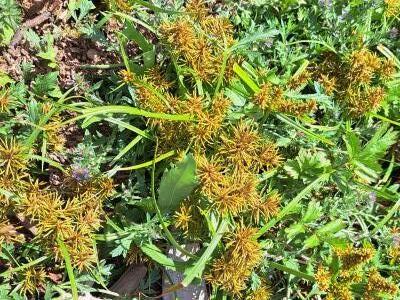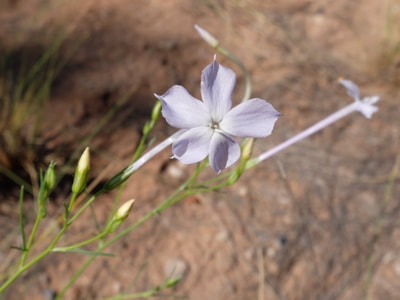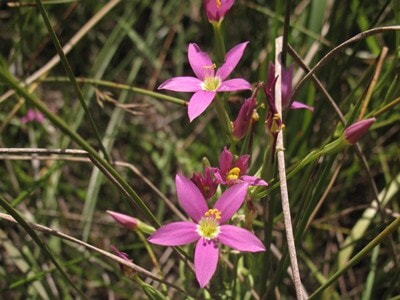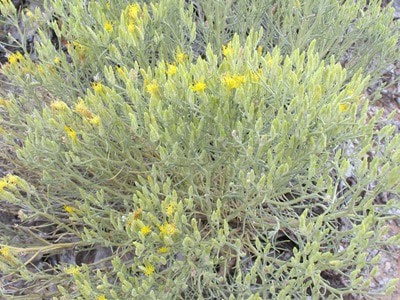|
Found in disturbed, muddy places
Seen blooming in September at Abiquiu Lake A walk around the peninsula at Abiquiu Lake has changed since the water level rose so high in the spring. In places there is now a broad green carpet of vegetation between the high-water mark and the current water level. Plants to be seen are Bracted Vervain, Cocklebur, Spotted Lady’s Thumb, Crownbeard, Ragweed, and two kinds of Flatsedge; all plants that like a moist environment and are not usually seen around Abiquiu Lake. I wonder what spring will bring. Rusty Flatsedge is a grass that can grow from 4 to 20 inches tall, these are about 8 inches. Grasses are wildflowers too but their flowers do not need to be showy to attract the birds and the bees because they are pollinated by the wind. Flatsedge stems are sharply three-sided. Its golden flower spikes turn rusty with age. As its name implies, the roots have a floral fragrance when crushed. Traditionally the seeds were eaten. If you are trying to identify a different flower then you can check what other flowers bloom this month. If you cannot identify a flower from the website, send a photo and where you took it to [email protected]. Read online for tips.
0 Comments
Found in open, sandy areas
Seen blooming in September by Arroyo Trujillo This delicate plant can grow to 40 inches tall with many branches and slender grey-green leaves and stems. Flowers are white, light blue or lavender with a floral tube up to 3 inches long. It blooms from spring to fall depending on the rains, as so many plants do. Native Americans used the plant in quite a variety of ways. An infusion of the roots was used to eliminate the ozone in cases of lightning shock. A decoction of the leaves was taken for stomachache, crushed leaves and flowers were steeped into a tea that was taken for headaches, used on sores, for arthritis, as an eyewash, and served as a hair tonic to prevent baldness and lengthen the hair. The plant was chewed together with salt to treat heartburn. An infusion of the flowers was mixed with feed and given to sheep with stomach disorders. A cold infusion of the plant was applied daily to heal the incision in a castrated colt. The Zuni people used a poultice of the dried, powdered flowers to remove hair on newborns and children. Source. If you are trying to identify a different flower then you can check what other flowers bloom this month. If you cannot identify a flower from the website, send a photo and where you took it to [email protected]. Read online for tips. Arizona Centaury, Arizona Mountain-Pink, Zeltnera arizonica, Gentian Family (Gentianaceae)9/15/2023 Found in moist, open areas, stream sides
Seen blooming in September by the Rio Chama Most of the flowers at this time of the year are yellow so it is a pleasure to see a pop of pink. Arizona Centaury grows to two feet tall with bright green upright stems. The leaves clasp the stems and are green, succulent and lance-shaped. The attractive flowers are one inch across and have five bright pink, narrowly oval petals, a white starburst center, and bright yellow stamens. I found no edible or medicinal uses for Arizona Centaury, it is just a pretty flower that blooms all summer. If you are trying to identify a different flower then you can check what other flowers bloom this month. If you cannot identify a flower from the website, send a photo and where you took it to [email protected]. Read online for tips. Curlycup Gumweed, Resinweed, Curlytop Gumweed,Grindelia squarrosa,Sunflower Family (Asteraceae)9/7/2023 Found at roadsides and in disturbed soil
Seen blooming in September by Highway 554 Gumweeds ooze a whitish, viscous, resinous fluid from their flower buds so are very recognizable. Curlycup Gumweed grows to two feet high in a bushy shape with green or whitish stems. Leaves are oblong and toothed with no stalks. Also very recognizable are the 5 to 6 rows of sticky, hooked bracts around the flower head. Petals may or may not be present. Gumweeds have been used for many medicinal purposes by Native Americans, including as a wash for poison oak rashes and burns and for pulmonary troubles. The resinous sap that covers the leaves has been used as a substitute for chewing gum. Green and yellow dyes can be obtained from the yellow flowering heads and pods. Grindelias are still used for asthma and bronchitis, and in common cough remedies in homeopathic medicine. Source. If you are trying to identify a different flower then you can check what other flowers bloom this month. If you cannot identify a flower from the website, send a photo and where you took it to [email protected]. Read online for tips. Found in sandy open areas, washes
Seen blooming in August near Hwy 554 in Abiquiu Chamisa, Rubber Rabbitbrush, is in full bloom around the area but there is another less common rabbitbrush also in bloom. Greene’s Rabbitbrush grows to only 20 inches high compared to the several feet that Chamisa can reach. It has upright green stems and bark that becomes shreddy and grey with age. Leaves are very narrow and greyish-green. Flower heads grow in dense clusters at the top of light green twigs and are no more than 1½ inches across. Much of the plant is covered with a resin that has a very pleasant smell. Traditionally the Hopi used Greene’s Rabbitbrush as prayer stick decorations and the Navajo used an infusion of plant tops as a wash for chickenpox and measles eruptions. Source. If you are trying to identify a different flower then you can check what other flowers bloom this month. If you cannot identify a flower from the website, send a photo and where you took it to [email protected]. Read online for tips. |
AuthorI am Marilyn Phillips, a native of England, whose love of nature and the outdoors from childhood brought me by a circuitous route to Crested Butte, Colorado in 1993 and 16 years later to northern New Mexico. My exploration of the many trails in these areas, my interest in wildflowers and photography, and career in computer system design came together in this creation. If you have any corrections, comments or questions, please contact me by email. Archives
July 2025
Categoriescopyright © 2020
|







 RSS Feed
RSS Feed